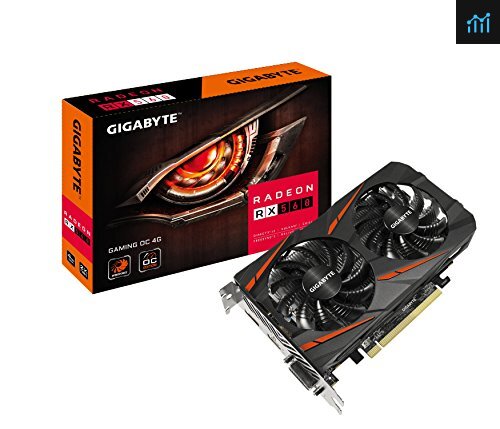Review and testing of the AMD Radeon RX 560 video card: Test | Specs | CPU | Config – Despite the fact that AMD last year updated the lineup of mobile video cards for laptops, laptops based on the new 500 series mobile video adapters began to appear on sale relatively recently. For some reason, laptop manufacturers gave their preference to a competitor in the person of Nvidia, bypassing AMD’s mobile graphics adapters.
Until recently, the Radeon RX 460 graphics card competed with the laptop GeForce GTX 1050, but in practice it turned out that there was no competitor from it, therefore, in order to at least somehow catch up with laptops with a GeForce GTX 1050, AMD launched the Radeon RX 560 on the market, which became the successor to the Radeon RX 460 The basis of the novelty was the full version of the GPU Polaris 11 with 1024 stream processors, and the higher frequencies were supposed to provide additional acceleration.
In fact, the mobile Radeon RX 560 is present on the market in two variations. Video cards differ in the amount of memory, there are also differences in GPU frequencies. Both are based on the Polaris 11 chip. 1024 unified processors are responsible for the operation of the video card, the number of texture units is 64, the rasterization units in the video card are the least – 16. The effective frequency of the video card can reach 1292 MHz, which is not too impressive compared to analogs from Nvidia. The memory capacity of the video adapter is 4 gigabytes, but there are versions for 2 gigabytes. The memory bus width is 128 bits, which will affect the slow loading of textures in heavy computer games. The frequency at which the video memory operates is 6000MHz, the GDDR5 standard.
Radeon RX 560 has full support for all current APIs: DirectX 12, Vulcan 1.0, OpenGL 4.5, and even specialized OpenCL 2.0. Like all modern AMD graphics adapters, the RX 560 comes with a dedicated hardware encoder called AMD VCE.
Specifications
| CPU |
|---|
| Polaris 11 |
| Technical process |
| 14 n.m. |
| GPU frequency MHz |
| 1172-1292 MHz |
| Stream Processors (Shading Units) |
| 1024 |
| Texture Units (TMUs) |
| 64 |
| Raster Operations Pipelines (ROPs) |
| 16 |
| Memory type |
| GDDR5 |
| Memory bus width |
| 128 pages |
| Memory size |
| 2-4 GB |
| Memory frequency |
| 1500 MHz (6000 MHz) |
| DirectX |
| 12 |
| Interfaces |
| – |
| Power consumption (TDP) |
| 50 watts |
| Price |
| – |
3DMark
3DMark Fire Strike is a beautiful and popular application with DirectX 11 API support for testing computers with high-performance gaming graphics cards in the Windows environment. 3DMark Fire Strike results help you evaluate the comparative performance of a video card and its suitability for the most demanding PC games.
3DMark – Fire Strike Graphics 1920×1080
AMD Radeon RX 550 (Lenovo IdeaPad 720)
5060
NVIDIA GeForce GTX 960M (MSI GL72 6QF )
4705
NVIDIA GeForce GTX 950M (Acer Aspire F15 F5-573G )
3556
NVIDIA GeForce GTX 1050 (Acer Aspire 7 A715-71G)
6167
AMD Radeon RX 560(Lenovo IdeaPad 720-15IKB)
6002
Literally FPS stands for “Frame per second”, or frames per second. Accordingly, the larger this number, the smoother the picture will be on the display during the game. How much FPS is needed for a comfortable game? It is difficult to unequivocally answer this question, if only because in different game engines with the same number of frames per second, the image quality can be different. However, there is a widespread belief that 30 FPS will be enough for a smooth game.
In modern games, the Radeon RX 560 will be able to provide medium, and in some projects even high graphics settings (depending on the requirements of the game) in FullHD resolution. But for UltraHD (4K) resolution, the performance of this video card is clearly not enough. In fact, the Radeon RX 560 is a budget-level graphics adapter and you should not expect high results from it. The performance of the RX 560 graphics card will not be enough for comfortable playing most of the top-end shooters and action games at maximum graphics settings. But RPGs are quite playable, as are online projects with good optimization. Next, we tested the AMD Radeon RX 560 in popular games at high graphics settings with a display resolution of 1920 x 1080 pixels, based on 60 frames per second (FPS).
Display resolution: 1920×1080 pixels. Graphics Settings: High
60FPS
Darksiders III
28FPS46%
Far Cry New Dawn
30FPS50%
Metro Exodus
13FPS21%
Battlefield V
40FPS66%
Call of Duty Black Ops 4
45FPS75%
Just Cause 4
25FPS41%
Display resolution: 1920×1080 pixels. Graphics Settings: High
60FPS
Shadow of the Tomb Raider
22FPS36%
Fallout 76
30FPS50%
Assassin´s Creed Odyssey
17FPS28%
Middle-earth: Shadow of War
28FPS46%
The Witcher 3
34FPS56%
Apex Legends
33FPS55%















